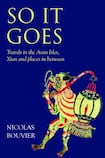
The Geneva-born writer Nicolas Bouvier (1929-1998) spoke several languages including fluent Japanese but always wrote in French. As with our own Hubert Butler, his fame came late but has spread far since his death. Other points in common are obvious: original thought processes, mislabelled “inconsistency” by a few cranky critics, a wide-ranging curiosity about the more obscure trends in other peoples’ histories, and an easy adaptation to unfamiliar (in every sense) environments.
Jeju is one of the “places in between”, a tropical island of some 1,200sq kms overlooked by its volcanic cone, Halla-san. During the first millennium BC humans arrived from the Korean peninsula, only a few days’ sailing away. Eventually a tiny, well-organised society emerged, matriarchal and shamanic but unrecorded until 477. Then its ruler sent a gift of pearls, amulets and pheasants to Paekche’s court on Korea’s southwest coast and received a thank-you letter. Eight centuries later, Kublai Khan introduced horse-breeding – small compensation for deforesting half the island to build a fleet for the invasion of Japan.
When another seven centuries had passed Bouvier and his wife Eliane climbed Halla-san in an endearingly amateurish way. A masochistic defiance of commonsense marked many Bouvier enterprises though his personal irresponsibility never endangered anyone else. On Halla-San, “The forest and its thorny undergrowth, where orchids hang like Chinese lanterns, are so dense that you need a machete to advance one step. I didn’t even have a knife”. Near the summit the exhausted couple came upon a ninth-century red stone Buddha, seven metres high, enfolded by ancient trees. Here Bouvier is at his most effective. Travellers following their own paths occasionally wander into nameless, hidden, silent spaces emanating “a clear trace of holiness”. Few of us have the words to adequately describe that good fortune.
In his 1985 Aran Journal he nominated the wind as the island's dominant character
On the way to Jeju in 1970, the Bouviers took the new Busan-Seoul express down the valley of the Nakdong river. Viennese waltzes came over the loudspeaker, prompting him to reflect on continental continuity: “Eurasia certainly exists.” In his and my youth this term was in general use, a recognition of the obvious. He recalled working on a dig in Bactria, handling coins from the first century BC “which bore inscriptions front and back in Greek, Indic and Chinese”. No surprise – the first generation of Marco Polo’s readers were Venetian merchants chiefly interested in “the price of lapis lazuli, transit times, sheltered anchorage – all information to do with commerce and trading. Such people now read the Wall Street Journal”. Between Seoul and Oslo, for instance, Bouvier sensed certain indefinable shared awarenesses and reactions, distinguishing us Eurasians from New Worlders. After all, he reckoned, a lone man in good health could, without great effort, get from Seoul to Geneva on foot. A similar realisation affected me at the age of 10; only two insignificant stretches of water separated my Co Waterford home from New Delhi.
Inishmore
Bouvier relished the Jeju/Inishmore contrast. In his 1985 Aran Journal he nominated the wind as the island’s dominant character with his elderly B&B host as runner-up. On arrival, he went down with a combination of fever and dysentery; his Galway hotel had been damp and unheated. Yet one evening, despite the February gales he walked 20km in darkness to absorb the rhythmic roar of the Atlantic far below. He warmed to tales of the sidhe, the earth mounds said to be home to fairies, in contrast to his eloquent ambiguity about the Samye Ling monastery in Scotland. One of his journal entries recalls the ninth-century Council of Valence condemning the “devilries” of the west of Ireland’s primitive monasticism.
More than once Bouvier refers to the Romans’ failure to conquer Ireland as the most important non-event in our history. It deprived us of “the infrastructure – logical, political, urban, epigraphical – which exists across southwest Europe”. Some authors are no good at small talk and on the one occasion when I met Bouvier (in Toronto over a pint) he speculated about the Celtic modern languages of Britain and Ireland. How to explain the importance of the “p” or “q” sounds? I could offer no view. He believed – a contentious point – that Celtic remained, throughout the Roman period, Britain’s most-used language beyond the cities.
When Bouvier heard uneasy mutterings about a threat to Inishmore, about unsuitable tourist-bait developments, his journal records: “Everywhere tourism is slammed: it’s fashionable to do it and often justifiable. In many cases it is a demeaning relationship, both for the tourists and for the people who try and always succeed in ripping them off.”
A generation later, one can’t discuss mass tourism in politically-correct language. As a powerfully polluting progeny of the consumer society, it can only be condemned. On every continent its despoliation of natural beauty is incalculable. It is never an educational project. It contributes little (though in rare circumstances that can be a significant little) to inter-racial harmony. As Bouvier bleakly concluded, “A rotten affair based on mutual misunderstanding”.
In a richly woven final essay, the eight-year-old Bouvier is intent on acquiring information about people, places and events far removed from the Vaud canton where he and his brother and sister grew up. Their maternal grandmother’s estate encompassed “hectares of wheat, woods, fields, which bordered the bushes on the banks of the Aubonne and the Grand Lac”. Meanwhile their talented but improvident young parents were enjoying bohemian life in Paris. During the 1930s many of grandma’s guests represented middle Europe’s most privileged and cultivated, apolitical intellectuals who averted their eyes from reality until the second-last moment. Afterwards, “the Americans organised visits to Dachau for those of the elderly who had shared this blindness and who had survived”.
In a publisher’s forward we learn, sadly, that So It Goes is “the final element of Eland’s homage to this exceptional chronicler of the world”.












